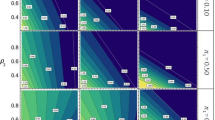Abstract
Controlled crosses and progeny testing are important components of tree breeding programs. Recently, a new approach, ‘breeding without breeding’ (BWB), has been proposed to obtain structured pedigrees for the breeding and testing from wind-pollinated progenies; the technique uses high-resolution markers instead of conventional approaches. The BWB approach is attractive for outcrossing conifers where the breeding cycle is long and reproductive maturity is often delayed. For the application of the BWB approach, the accurate assignment of parents is essential. The first step in the application of the BWB approach is to conduct tests into the reliability of paternity and parent-pair exclusion procedures in complex situations. In this study we conducted multi-locus-based empirical and simulation analyses for a Scots pine seed orchard crop, in order to develop the appropriate parentage assignment techniques for BWB and to investigate whether pedigrees from a seed orchard crop can be determined with sufficient accuracy. The results were promising, as 93–97% of the seeds generated by mating among the seed orchard clones were correctly assigned to a parent-pair. When mating occurred with foreign pollen, the success rate of identifying mother clones was 60–78%. Based on these results, we propose three novel low input breeding strategies for forest trees. The principles of the different options and their potential benefits and costs are described and discussed using Scots pine as a case study.

Similar content being viewed by others
References
Dakin EE, Avise JC (2004) Microsatellite null alleles in parentage analysis. Heredity 93:504–509
El-Kassaby YA, Lindgren D (2008) Increasing the efficiency of breeding without breeding through phenotypic pre-selection in open pollinated progenies. In: Byram ED (ed) Proceeding of 29th STFIC/WFGA meeting, Galveston Texas, pp 15–19
El-Kassaby YA, Lstibůrek M (2009) Breeding without breeding. Genetics Research 91:111–120
El-Kassaby Y, Lstibůrek M, Liewlaksaneeyanawin C, Slavov GT, Howe GT (2007) Breeding without breeding: approach, example, and proof of concept. In: Isik F (ed) Proceedings of the IUFRO division 2 joint conference: low input breeding and conservation of forest genetic resources. Antalya, Turkey, pp 43–54
Fedorkov A, Lindgren D, David A (2005) Genetic gain and gene diversity following thinning in a half-sib plantation. Silvae Genet 54:185–189
Goto S, Shimatani K, Yoshimaru H, Takahashi Y (2006) Fat-tailed gene flow in the dioecious canopy tree species Fraxinus mandshurica var. japonica revealed by microsatellites. Mol Ecol 15:2985–2996
Hannrup B, Jansson G, Danell O (2007) Comparing gain and optimum test size from progeny testing and phenotypic selection in Pinus sylvestris. Can J For Res 37:1227–1235
Jamieson A, Taylor SS (1997) Comparisons of three probability formulae for parentage exclusion. Anim Genet 28:397–400
Jones AG, Ardren WR (2003) Methods of parentage analysis in natural populations. Mol Ecol 12:2511–2523
Kalinowski ST, Taper ML, Marshall TC (2007) Revising how the computer program CERVUS accommodates genotyping error increases success in paternity assignment. Mol Ecol 16:1099–1106
Lindgren D, Wei RP (2007) Low-input tree breeding strategies. In: Isik F (ed) Proceedings of the IUFRO division 2 joint conference: low input breeding and conservation of forest genetic resources, Antalya, Turkey, pp 124–138
Lindgren D, Karlsson B, Andersson B, Prescher F (2008) The Swedish seed orchard program for Scots pine and Norway spruce. In: Lindgren D (ed) Proceedings of seed orchard conference, Umeå, Sweden, 26–28 September 2007, pp 142–154
Marshall TC, Slate J, Kruuk LEB, Pemberton JM (1998) Statistical confidence for likelihood-based paternity inference in natural populations. Mol Ecol 7:639–655
McKeand SE, Gerwig DM, Cumbie WP, Jett JB (2008) Seed orchard management strategies for deployment of intensively selected loblolly pine families in the southern US. In: Lindgren D (ed) Proceedings of seed orchard conference, Umeå, Sweden, 26–28 September, 2007, pp 177–182
Meagher TR (1986) Analysis of paternity within a natural population of Chamaelirium luteum. 1. Identification of most-likely male parents. Am Nat 128:199–215
Meuwissen THE, Hayes BJ, Goddard ME (2001) Prediction of total genetic value using genome-wide dense marker maps. Genetics 157:1819–1829
Moriguchi Y, Taira H, Tani N, Tsumura Y (2004) Variation of paternal contribution in a seed orchard of Cryptomeria japonica determined using microsatellite markers. Can J For Res 34:1683–1690
Rosvall O, Jansson G, Andersson B, Ericsson T, B. K, Sonesson J, Stener L-G (2001) Genetic gain from present and future seed orchards and clone mixtures. The Forestry Research Institute of Sweden, Rep. 1, pp 36–41
Ruotsalainen S (2002) Managing breeding stock in the initiation of a long-term tree breeding program. PhD Thesis, Faculty of Agriculture and Forestry, University of Helsinki, ISBN 951-40-1860-5
Torimaru T, Wang XR, Fries A, Andersson B, Lindgren D (2009) Evaluation of pollen contamination in an advanced Scots pine seed orchard. Silvae Genetica (in press)
Vandeputte S, Mauger S, Dupont-Nivet M (2006) An evaluation of allowing for mismatches as a way to manage genotyping errors in parentage assignment by exclusion. Mol Ecol Notes 6:265–267
Acknowledgements
This study was financially supported by the Swedish Association of Forest Tree Breeding and the Kempe foundation. We thank the staff at Skogforsk, Sävar, for seed extraction and Svenska skogsplantor and Holmen for allowing access to the seed orchard and for information about the orchard. We thank Rosario Garcia Gil for recommendations on SSR loci at the start of the study, and Matti Haapanen for stimulating discussions about breeding strategies.
Author information
Authors and Affiliations
Corresponding author
Additional information
Communicated by Y. Tsumura
Rights and permissions
About this article
Cite this article
Wang, XR., Torimaru, T., Lindgren, D. et al. Marker-based parentage analysis facilitates low input ‘breeding without breeding’ strategies for forest trees. Tree Genetics & Genomes 6, 227–235 (2010). https://doi.org/10.1007/s11295-009-0243-8
Received:
Revised:
Accepted:
Published:
Issue Date:
DOI: https://doi.org/10.1007/s11295-009-0243-8




